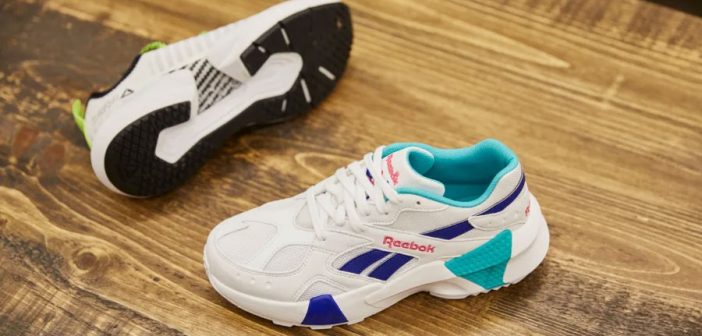The demand for “dad” sneakers is driving Reebok to rerelease (and remix) more of its designs from the ’90s.
Five years ago, sneakerologists noticed a sudden shift in millennials’ choice of kicks.
Twentysomethings–dressed from head to toe in athleisure–were ditching their high-performance athletic shoes for iconic sneaker silhouettes of the 1980s and ’90s. Of course, some sneakerheads have always been into old-school sneakers, but overnight this obsession with vintage shoes was going mainstream. Why were millennials rummaging through the deepest corners of their parents’ closets for their old shoes?
Carlos Escobar, a designer at Reebok, saw this nostalgia unfolding around the world, from the subways of New York to hip neighborhoods in Paris to the shopping streets of Berlin. “Young people seemed to have a kind of longing for the past,” he says. “And it was playing out in their sneakers.”
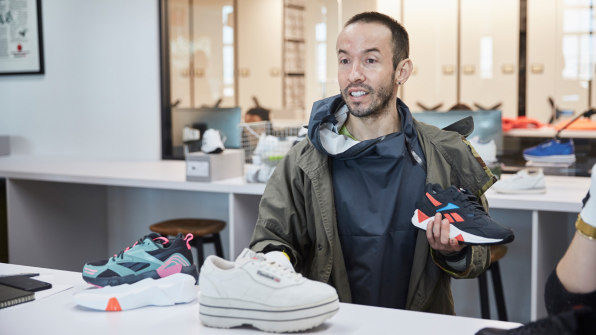
A “SUDDEN SURGE” IN CLASSIC SNEAKERS
Escobar wasn’t imagining it. Back at Reebok’s Boston headquarters, the company saw consecutive double-digit growth starting in 2014 in its Classics business, which recreates iconic sneakers from the past. According to the company’s data, millennials and gen Z consumers were driving the trend, snapping up old-school high-tops and leather kicks. It’s no wonder that everywhere young people hung out–from college campuses to hip New York or L.A. cafés–vintage Reebok styles kept popping up.
Today, Classics makes up 40% of Reebok’s total sales, outpacing its performance shoe division, which focuses on using technology to create shoes for sports and fitness. Kelly Hibler, who became the GM of Reebok Classics in 2017 after 28 years at Nike, says this explosion in vintage sneakers happened across brands. “It was clear to everyone in the industry,” he says. “There was a sudden surge in sales of these classic styles.”
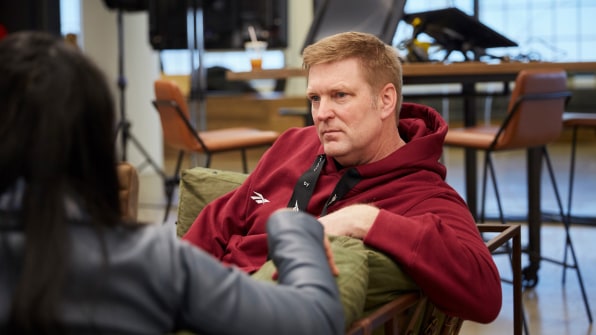
Hibler estimates that there are about 15 iconic sneakers (known in the industry as “franchises”) on the market that reached enough popularity when they were introduced to endure today. These include Converse’s Chuck Taylors, Nike’s Air Jordan, or Adidas’s Superstar. But Reebok, which is much smaller than its competitors and has less than 2% of the athletic shoe market, happens to have at least four iconic styles.There’s the Classic Leather, which was first debuted in 1983, and is known for its white leather exterior and contrasting gum soles, featuring the brand’s earliest logo, which has the British flag on it. There’s the Freestyle high-tops, first launched in 1982 to complement women’s neon-colored aerobics outfits. There’s the Club C, a slim white tennis shoe first launched in 1985 that captures the preppy country club aesthetic. And there’s the InstaPump Fury, the 1994 sensation with an actual pump on the tongue.
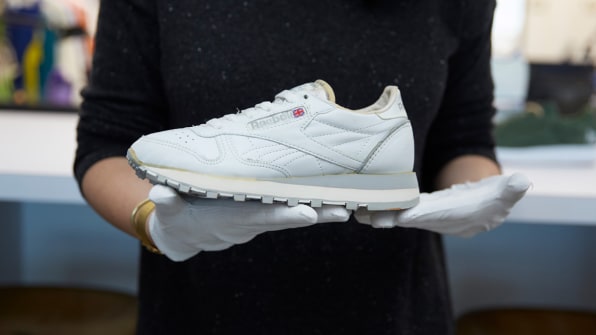
Hibler says it’s hard to predict when a shoe will reach this level of public awareness. It’s some alchemy of creating a shoe that looks unique and taps into some cultural trend, but there’s also an element of luck. “As a brand, we don’t really get to decide which of our shoes become franchises,” he says. “The consumer determines what these styles are and all we can do is respond to them.”
Reebok has been struggling financially for decades and did not fare better after Adidas bought the company in 2005 for $3.8 billion. In 2018, Reebok’s revenues fell by 3%, and as recently as last year Adidas was considering divesting itself of the brand. The Classics business could clearly be a key to turning things around. “Reebok has recognized that managing our franchises could be the most important thing we do,” Hibler says. “There are only a handful of shoes that people know by name around the world and that have survived decades.”
To keep the Classics business growing, Reebok has been scouring its archive to recreate some of its iconic designs from the past. But Hibler and his team believe they can do more. Give the customer the same old shoes again and again, and they’ll get bored. So Reebok’s designers have been working to gently tweak and update these silhouettes to keep customers interested and coming back for more.
But it’s a delicate balance. “Change a classic too much, and the shoe loses all meaning,” says Escobar. “But fail to offer newness, and the customer loses interest.”
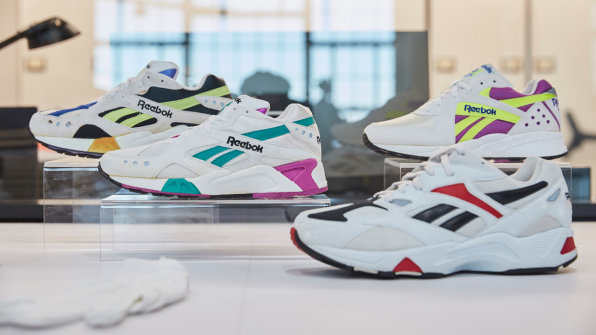
NOSTALGIA FOR THE PAST, DISSATISFACTION WITH THE PRESENT
Reebok executives are still scratching their heads, trying to figure out exactly why millennials–and now, gen-Zers–are so fascinated with these classic sneakers.
Part of it may have to do with the strange times we find ourselves in. Pew Research has found that American millennials and generation Z are not satisfied with the current state of politics, with about 70% saying they disapprove of the Trump presidency and a similar number saying they think the government should be doing more to solve problems. “This is a chaotic time for young people,” Hibler says. “The thing about iconic shoes is that they are usually something that your uncle or your dad or your older brother wore. There is often comfort in that, because it feels familiar.”
But as the designers explored this nostalgia, they realized that today’s teens and twentysomethings don’t actually know where each sneaker is situated historically. As they talked to consumers in focus groups, they began to see that the design’s exact origin didn’t matter. In fact Frank Rivera, who manages communication for the Classics line, says that young people often lump various vintage styles together.
“At first, we thought about Classics in a very rigid way, thinking about each shoe and the era it represented,” he says. “We respected each style to the point that we kept them segmented. But what we discovered that our customers don’t think like that.”
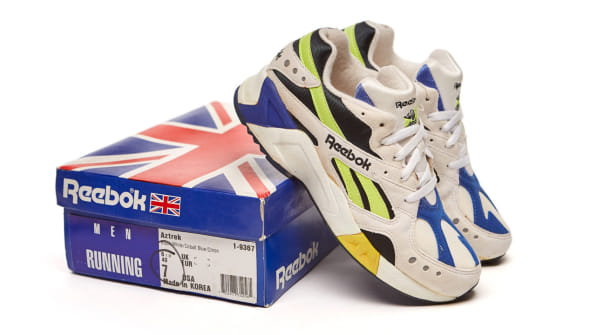
He points out that when a twentysomething stumbles onto different pairs of sneakers in their parents’ closet, they’re not thinking about whether they are from the ’80s or ’90s. Rivera’s theory is that what matters to these younger consumers is that the shoes remind them of their youth, or of old family pictures. They are attracted to classics because they are reminded of their dad’s tennis shoes or mom’s aerobic shoes.
For Reebok’s designers, the awareness that the classic shoes are connected to a general feeling of nostalgia and continuity with the past was hugely liberating, because it means they’re not limited to accurately recreating looks from the past. “We can blur the lines between decades and eras,” says Rivera. “We can put a new spin on a Classic shoe to give it new energy and excitement, but the customer still feels like it reminds them of another era. We wanted to give customers new reasons to be interested in us.”
Hibler believes that young consumers like seeing multiple reference points from the past in a single sneaker because this mimics how they process history. They’re not necessarily thinking history in terms of a linear narrative, but see artifacts from different eras–like the spandex aerobics outfits of the ’80s and the chunky basketball sneakers of the ’90s–as representing the fashion trends of their parents’ generation. This is partly a product of the internet. When someone does a Google search for, say, “vintage sneakers,” they see images of different shoes and different aesthetics appear next to one another. And all of this creates a composite of what an era or style means to them. “Customers are digesting a lot of information very quickly,” he says. “This has opened up the lens of what Classics can be.”

HACKING HISTORY
Reebok has been leaning into this idea of not being too precious with iconic styles. Earlier this year, Rivera led an ambitious new project called “Alter The Icons,” where the company revived 10 silhouettes from the past, including the Classic Leather and the DMX, but put bold new twists on them by incorporating colors and textures that weren’t in the original.
A black Classic Leather sneaker from the collection is vaguely reminiscent of the one your dad wore in the 1980s, but when you take a closer look, you see it has a chunkier sole and part of it is made from black denim. On one part of the sole, there’s a little Reebok vector logo that the brand phased out in the mid-2000s, again calling to mind an image from the past. “Normally that logo and that product don’t coexist,” says Rivera. “But we like the idea of hacking our heritage, blending different parts of our heritage and history.”
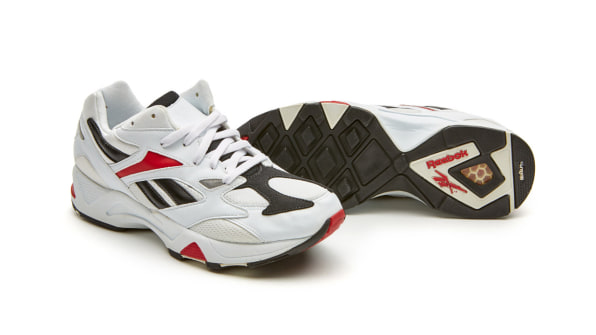
The company is also exploring other corners of its archive that the average customer may be less familiar with. Right now, the company is working to revive the Aztrek, Reebok’s all-terrain hiking shoe that was first released in 1993. Escobar believes this is the right time to bring it back because it is playing into a broader fashion trend he was seeing in the market.
“Trail shoes are going to be big this year,” he says. “We thought we could play into this trend in our own unique way, drawing from our own history. Fashion goes in cycles, so there’s always an opportunity to bring back something from the archives.”
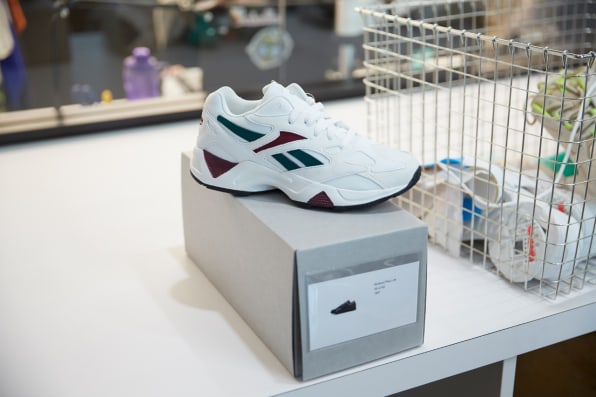
Reebok is releasing several updated versions of the Aztrek Double, with a particularly chunky sole that almost looks like a platform. Most people remember the version of the shoe that came in blue and green. The brand collaborated with Gigi Hadid to create a version of the shoe in similarly bold, contrasting colors: orange and yellow, and black and blue. “Gigi was drawn to the shoe because it first came to market around the time she was born,” says Escobar. “It was a nod to the sensibilities of that decade, with both the color scheme and the silhouette.”
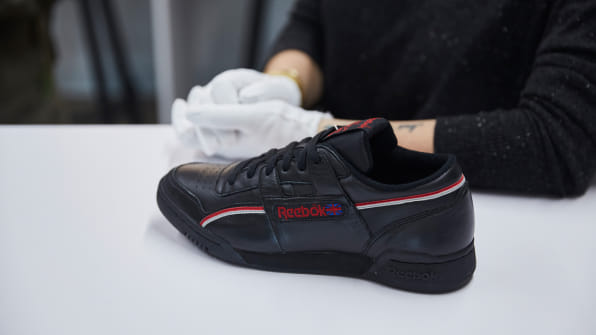
SO WHAT HAPPENS WHEN CLASSICS GO BACK OUT OF STYLE?
Reebok was quick to spot the fascination in these ’80s and ’90s styles, and has been exploiting this trend by bringing a slew of vintage-inspired sneakers to market. But what happens when the trends shift yet again, and consumers suddenly lose their taste for classics? Hibler, who has been in the sneaker business for three decades now, wouldn’t be surprised if this happens. In his experience, trends can be fickle. “We know that customers are interested in classics now, and we’re trying to give them new, exciting options to choose from,” he says. “But it’s possible that one day they won’t be as driven by nostalgia.”
For him, the lesson from the past four years is to be listening to customers, and be flexible enough as a company to address their needs. He says Reebok has poured a lot of resources into the Classics brand, bringing on teams of designers and marketers to focus on the trend. But if customers lose their interest in old-school shoes, he says the company will need to regroup and focus on, say, the performance footwear part of the business.
But one thing’s for sure: Even if the vintage sneakers are no longer hip in mainstream culture, it is vital for Reebok to hold on to its heritage by keeping its most iconic silhouettes alive. After all, you never know when the next wave of nostalgia will hit. “These are shoes that have become part of culture and history,” he says. “We have a responsibility as a brand to protect these franchises and remember our heritage.”
–
This article first appeared in www.fastcompany.com
Seeking to build and grow your brand using the force of consumer insight, strategic foresight, creative disruption and technology prowess? Talk to us at +9714 3867728 or mail: info@groupisd.com or visit www.groupisd.com

